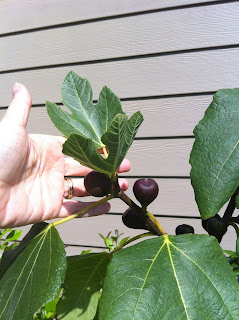 |
| Blueberry and raspberry soda |
Sunday, July 31, 2016
Plain water is just that-plain. So many people go to sodas or other sweetened, store bought drinks for refreshment. There are other home grown options, fresh from the garden!
Here are a few flavored water recipes
For these infusions, place ingredients in a half gallon of water and allow to meld overnight. Shake, then strain into serving container. Chill for a refreshing, tasty water!
Lemongrass, mint and vanilla-1 large stalk of lemongrass, chopped and crushed, 1/4 cup fresh peppermint coarsely chopped, and 1/2 large vanilla bean or 1 teas vanilla extract.
Cardamom, orange and vanilla-1 large sliced orange, 1 tablespoon crushed cardamom pods, 1/2 large vanilla bean or 1 teas vanilla extract.
Blackberry, rose and vanilla-3/4 cup blackberries, 1/4 cup rose petals, 1/2 large vanilla bean.
Refreshing cucumber mint-1/2 cup chopped and crushed mint with half a sliced cucumber.
Of course, there is always the old fashioned favorite! Lemonade or limeade-simply squeeze fresh lemon or lime juice into water.
1/8-1/4 teaspoon of stevia can be added to any of the above for added sweetness with no sugar or carbs. Too much stevia can impart a bitter taste; a little goes a long way!
Stevia is an herb high in antioxidants that is very easy to grow and overwinter in your garage. You can find them almost anywhere that herbal plants are sold. Dry the leaves and use to sweeten anything. Stevia can also be purchased at the store. I would stick with the whole herb to get all the antioxidant benefits.
I bought a book called "Stevia naturally sweet recipes for desserts, drinks and more!" by Rita DePuydt that has great ideas for using stevia to cut down or eliminate sugar and carbs in many sweetened foods and drinks.
Making your own vanilla is easy, too. Just buy vanilla beans, slit them open and place 4 of them in 1 cup (8 ounces) of premium vodka and allow to infuse for 4-6 months. If you want to speed up the process, shake weekly and it will be ready to use in 8 weeks. As you use it, you can just re-top. Very inexpensive way to have real vanilla.
I buy cardamom at Whole Foods in the bulk spices department or on-line. There are many options on Amazon. Cardamom is a great spice to add to hot tea, too. It is very warming. A great addition when cool fall temps arrive.
 |
| Cucumber and mint |
You can make your own sodas at home!
For a fruit flavored soda, use 1 cup of fruit, 1 cup of sugar (more or less depending on how sweet the fruit is that you are using), 1 cup apple cider vinegar. Heat the sliced fruit, 1/2 cup of sugar, and vinegar over high heat until it boils. Reduce and simmer until fruit is soft and sugar dissolved. Add more sugar if too tart. When cool, mash the fruit and strain liquid into a jar. Store in fridge for up to 2 weeks. For a soda, add 3 tablespoons of syrup into 8 ounces of carbonated cold water.
If you want to go the sugar-free route, substitute 1/2 teaspoon powdered stevia extract for the sugar. Again, be careful in not overdoing the stevia; too much imparts a bitter taste. You can use a combo of stevia with agave nectar, sugar or honey to find a sweetness you like. The less sugar you use, the better for your health.
For a homemade ginger ale, slice 1/4 cup of ginger root and 1/2 lemon or lime, 4 cups of water, simmer in pan for 20 minutes, strain into a glass jar, add 1/2 teaspoon of powdered stevia extract. Add equal amounts of ginger liquid and sparkling water.
You can do the same thing with mint, basil, rosemary, lemon verbena, cilantro, or dill. These syrups can be used in sodas or in adult beverages like the mint julep, margaritas, daiquiris, martinis, gin/vodka gimlets, gin and tonics, sangrias. Let your imagination run herb wild!
There are relatively inexpensive carbonators available nowadays as well. If you drink a lot of soda, this could be a very cost effective, nutritious approach.
For tips on growing the ingredients, here are some blogs:







